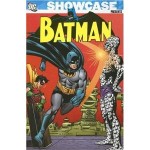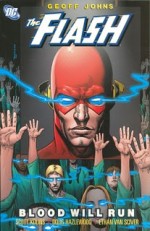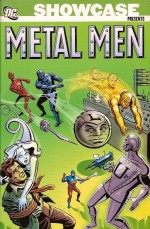
By Denny O’Neil, Neal Adams, Dick Giordano, Mike Grell & various (DC Comics)
ISBN: 978-0-85768-224-6
Returning to the usual phonebook-sized black and white tome, this fifth collection starring the Emerald Gladiator of Earth-1 (re-presenting the contents of Green Lantern/Green Arrow #76-89 – barring the all-reprint #88 – and the emerald back-up strips from Flash #217-221, 223-224, 226-228, 230-231, 237-238, 240-243, 245-246) generated groundbreaking, landmark tales from Denny O’Neil & Neal Adams that totally revolutionised the industry, whilst registering such poor sales that the series was cancelled and the heroes unceremoniously shipped into the back of another comicbook. Gradually the emphasis shifted back to crime, adventure and space opera and Green Lantern grew popular enough for his own solo title once more….
By the end of the 1960s America was a bubbling cauldron of social turmoil and experimentation. Everything was challenged and with issue #76 (April 1970 and the first issue of the new decade) Denny O’Neil and comics iconoclast Neal Adams utterly redefined superhero strips with their relevancy-driven stories; transforming complacent establishment masked boy-scouts into uncertain, questioning champions and strident explorers of the revolution.
‘No Evil Shall Escape My Sight!’ (inked by Frank Giacoia) is a landmark in the medium, utterly re-positioning the very concept of the costumed crusader as newly-minted ardent liberal Green Arrow challenged GL’s cosy worldview when the lofty space-cop painfully discovered real villains wore business suits, had expense accounts, hurt people just because of skin colour and would happily poison their own nests for short-term gain…
Of course, the fact that the story is a brilliant crime-thriller with science-fiction overtones magnificently illustrated doesn’t hurt either…
O’ Neil became sole scripter with this story and, in tight collaboration with ultra-realistic art-genius Adams, instantly overturned contemporary costumed dramas with their societally-targeted relevancy-driven protest-stories. The book became Green Lantern/Green Arrow with Emerald Archer Oliver Queen constantly mouthing off as a radical, liberal sounding-board and platform for a generation-in-crisis whilst staid, quasi-reactionary GL Hal Jordan played the part of the oblivious but well-meaning old guard.
At least the Ring-Slinger was aware of his faults and more or less willing to listen to new ideas…
At the time this compendium of stories first appeared DC was a company in transition – as indeed was America itself – with new ideas (which, in comic-book terms meant “young writersâ€) being given much leeway: a veritable wave of fresh, raw talent akin to the very start of the industry, when excitable young creators ran wild with imagination… Their cause wasn’t hurt by an industry in rapid commercial decline: costs were up and the kids just weren’t buying funnybooks in the volumes they used to…
‘Journey to Desolation’ in #77 was every bit as groundbreaking.
At the conclusion of the last issue an immortal Guardian of the Universe – hereafter known as “the Old Timer†was assigned to accompany the Emerald Duo on a voyage to “discover Americaâ€: a soul-searching social exploration into the dichotomies which divided the nation. First stop brought the trio to a poverty-stricken mining town run as a private kingdom by a ruthless entrepreneur happy to use agent-provocateurs and Nazi war criminals to keep his wage slaves in line.
When a young protest singer looked likely to become the next Bob Dylan and draw unwelcome publicity, he had to be eliminated – as did the three strangers who drove into town at just the wrong moment…
Although the heroes provided temporary solutions and put away viciously human criminals, these tales were remarkably blunt in exposing bigger ills and issues that couldn’t be fixed with a wave of a Green Ring; invoking an aura of helplessness that was metaphorically emphasised during this story when Hal was summarily stripped of much of his power for no longer being the willing, unquestioning stooge of his officious, high-and-mighty alien masters…
The confused and far-more-mortal Green Lantern discovered another unpalatable aspect of human nature in ‘A Kind of Loving, a Way of Death!’ when Black Canary joined the peripatetic cast. Seeking to renew her relationship with Green Arrow, she was waylaid by bikers, grievously injured and taken in by a charismatic hippy guru. Unfortunately Joshua was more Manson than Messiah and his brand of Peace and Love only extended to white people: everybody else was simply target practise…
The plight of Native Americans was stunningly high-lighted in ‘Ulysses Star is Still Alive!’ as corporate logging interests attempted to deprive a mountain tribe of their very last scraps of heritage, once more causing the Green Knights to take extraordinarily differing courses of action to help, whilst #80 added a science fiction gloss to a tale of judicial malfeasance in ‘Even an Immortal Can Die!’ (inked by Dick Giordano).
When the Old Timer used his powers to save Green Lantern rather than prevent a pollution catastrophe in the Pacific Northwest, he was chastised by his fellow Guardians and dispatched to the planet Gallo for judgement by the supreme arbiters of Law in the universe.
His earthly friends accompanied him and found a disturbing new administration with a decidedly off-kilter view of justice…
Adams’ staggering facility for capturing likenesses added extra-piquancy to this yarn that we’re just not equipped to grasp four decades later, with the usurping, overbearing villain derived from the Judge of the infamous trial of anti-war protesters “The Chicago Eightâ€.
Insight into the Guardians’ history underpinned ‘Death Be My Destiny!’ when Lantern, Arrow and Canary travelled with the now-sentenced Old Timer to the ancient world of Maltus (that’s a pun, son: just type Thomas Robert Malthus into your search engine of choice or even look in a book) and found a world literally choking on its own out-of-control population. The uncanny cause cast unlovely light on the perceived role and worth of women in modern society…
Green Lantern/Green Arrow #82 returned briefly to traditional yarn-spinning in ‘How do you Fight a Nightmare?’ (with additional inks from Berni Wrightson) as Green Lantern’s greatest foe unleashed Harpies, Amazons and all manner of female furies on the hapless hero before Black Canary and Green Arrow could turn the tide, whilst ‘…And a Child Shall Destroy Them!’ crept into Hitchcock country to reintroduce Hal Jordan’s old flame Carol Ferris and take a pop at education and discipline in the chilling tale of a supernal mutant in thrall to a doctrinaire little martinet.
Wrightson also inked #84’s staggering attack on out-of-control consumerism, shoddy cost-cutting and the seduction of bread and circuses in ‘Peril in Plastic’ before the comics world changed forever in the two-part saga ‘Snowbirds Don’t Fly’ and ‘They Say It’ll Kill Me…But They Won’t Say When!’
Depiction of drug abuse had been strictly proscribed in comicbooks since the advent of the Comics Code Authority, but by 1971 the elephant in the room was too big to ignore and both Marvel and DC addressed the issue in startlingly powerful tales that opened Pandora’s dirty box forever. When the Green Gladiators were drawn into conflict with a vicious heroin-smuggling gang Oliver Queen was horrified to discover his own sidekick had become an addict…
This sordid, nasty tale did more than merely preach or condemn, but actively sought to explain why young people turned to drugs, just what the consequences could be and even hinted at solutions older people and parents might not want to consider. Forty years on it might all seem a little naïve, but the earnest drive to do something and the sheer dark power of the story still delivers a stunning punch.
For all the critical acclaim and astonishingly innovative work done, sales of Green Lantern/Green Arrow were in a critical nosedive and nothing seemed able to stop the rot. Issue #87 featured two solo tales, the first of which ‘Beware My Power!’ introduced a bold new character to the DCU. John Stewart was a radical activist: an angry black man always spoiling for a fight and prepared to take guff from no-one. Hal Jordan was convinced the Guardians had erred when they appointed Stewart as Green Lantern’s official stand-in, but when a bigoted US presidential candidate tried to foment a race war the Emerald Gladiator was forced to change his tune.
Meanwhile bankrupted millionaire Oliver Queen was faced with a difficult decision when the retiring Mayor of Star City invited him to run for his office. ‘What Can One Man Do?’ written by Elliot Maggin, posed fascinating questions for the proud rebel by inviting him to join “the establishment†he despised, and do some lasting good. The decision was muddied by well-meaning advice from his fellow superheroes and the tragic consequences of a senseless street riot…
Issue #88 was a collection of reprints (not included here) and the series went out on an evocative, allegorical high note in #89 as ‘…And Through Him Save a World…’ (inked by Adams) pitted jobs and self-interest at Carol Ferris’ aviation company against clean air and pure streams in an naturalistic fable wherein an ecological Christ-figure made the ultimate sacrifice to save our planet and where all the Green Heroes’ power could not affect the outcome…
Although the groundbreaking series folded there, the heroics resumed a few months later in the back of The Flash #217 (August-September 1972). ‘The Killing of an Archer!’ began a run of short episodes which eventually led to Green Lantern regaining his own solo series. The O’Neil, Adams & Giordano thriller related how Green Arrow made a fatal mistake and accidentally ended the life of a criminal he was battling. Devastated, the broken swashbuckler abandoned his life and headed for the wilderness to atone or die…
The next episode ramped up the tension as a plot against the Archer was uncovered by Green Lantern and Black Canary in ‘Green Arrow is Dead!’ whilst ‘The Fate of an Archer’ saw Canary critically injured and GL track down Oliver Queen just in time to save her life…
Dick Giordano assumed full illustration duties with ‘Duel for a Death List!’ and the concluding ‘Death-Threat on Titan!’ (Flash #220-221) as the feature returned to its science fiction roots to concentrate solely on Green Lantern once more. In this pacy yarn aliens with an ancient link to the GL Corps began eliminating ring-wielders in preparation for a fantastic strike against the Guardians of the Universe.
Issue #223 continued the interstellar intrigue as an alien interloper attacked in ‘Doomsday… Minus Ten Minutes!’ whilst the next issue presented a clever, thoroughly grounded crime-caper ‘Yellow is a Dirty Little Color!’
In #226-Neal Adams drew his last GL tale ‘The Powerless Power Ring!’ before Dick Dillin, Giordano & Giacoia completed the trilogy in #227-228 with ‘My Ring… My Enemy!’ and ‘My Enemy… Myself!’ wherein atmospheric phenomena, bad mushrooms and invading aliens all combined to make the will-powered weapon a lethal liability.
Flash #230-231 featured ‘The Man From Yesterday!’ and ‘The Man of Destiny!’ (Dillin & Tex Blaisdell) as GL saved one of America’s Revolutionary heroes from aliens who had shanghaied him centuries previously, whilst #233-234 ‘World That Bet on War!’ & ‘And the Winner is Death!’ (Dillin, Terry Austin & Giordano) pitted the Emerald Avenger against gambling-crazed extraterrestrials who used soldiers from Earth history as their games-pieces…
With Flash #237-238 and 240-243 new art sensation Mike Grell came aboard for a six part saga that precipitated Green Lantern back into his own title. Beginning with ‘Let There Be Darkness!’ (inked by Bill Draut) the watchword was “cosmic†as the extra-galactic Ravagers of Olys undertook six destructive, unholy tasks in Green Lantern’s space sector. After thwarting their scheme to occlude the sun over planet Zerbon, destroying the photosynthetic inhabitants, the hero picked up a semi-sentient starfish sidekick in ‘The Day of the Falling Sky!’(Blaisdell inks) whilst preventing the artificial world of Vivarium from collapsing in upon itself.
‘The Floods Will Come!’ brought the Olys to planets Archos, where they attempted to submerge all the landmasses and drown the stone-age dwellers thriving there and Jotham, where the Ravagers almost extinguished the sun in ‘To Kill a Star!’
Earth was the target in ‘All Creatures Great and Small!’ as the Olys used their incredible technology to shrink all mammals but no sooner had Green Lantern negated that threat than the invaders’ de-evolutionary weapons were activated in ‘Dust of the Earth!’ (Austin inks).
Luckily a hominid GL was even more formidable than his Homo Sapiens self…
The buzz of the O’Neil/Grell epic assured Green Lantern of his own series once more, but before the re-launch Flash #345-346 presented one last two-part, back-up bonanza as Dillin & Austin illustrated the eerie mutation of vegetable-themed villain Jason Woodrue who transformed himself into a horrendous monster in ‘Perilous Plan of the Plant Master!’ before subjecting GL to ‘The Fury of the Floronic Man!‘
From challenging tales of social injustice back to plot-driven sagas of wit and courage, packed with a shining, optimistic sense of wonder and bristling with high-octane action, these evergreen adventures signalled the end of the Silver Age of Comics. Illustrated by some of the most revered names in the business, the exploits in this volume closed one chapter in the life of Green Lantern and opened the doors to today’s sleek and stellar sentinel of the stars.
© 1970, 1971, 1972, 1973, 1974, 1975, 1976, 1977, 2011 DC Comics. All Rights Reserved.










